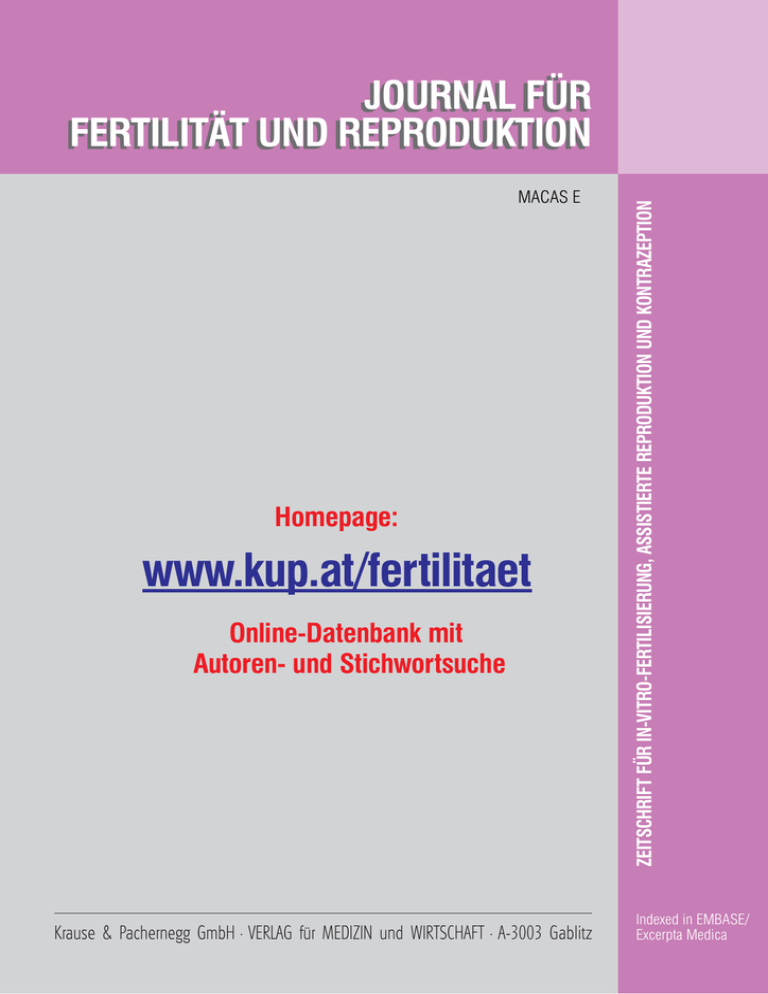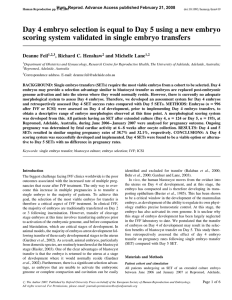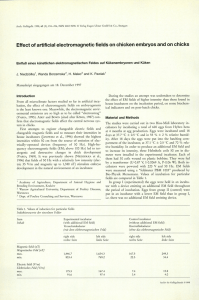Metabolic Status of the Oocyte and IVF success
Werbung

MACAS E Metabolic Status of the Oocyte and IVF success - is there a Relationship? Journal für Fertilität und Reproduktion 2006; 16 (4) (Ausgabe für Österreich), 16-18 Journal für Fertilität und Reproduktion 2006; 16 (4) (Ausgabe für Schweiz), 26-28 Homepage: www.kup.at/fertilitaet Online-Datenbank mit Autoren- und Stichwortsuche Krause & Pachernegg GmbH · VERLAG für MEDIZIN und WIRTSCHAFT · A-3003 Gablitz ZEITSCHRIFT FÜR IN-VITRO-FERTILISIERUNG, ASSISTIERTE REPRODUKTION UND KONTRAZEPTION JOURNAL FÜR FERTILITÄT UND REPRODUKTION Indexed in EMBASE/ Excerpta Medica Metabolic status of oocyte and IVF success – is there a relationship? E. Macas Careful selection of embryos and prediction of implantation is perhaps the most critical issue in the assisted reproduction medicine. Meanwhile numerous of methods that allow the selection of the most viable embryo for transfer have been proposed. Pronuclear zygote morphology for instance has been recommended as one of the simplest method of embryo-selection. For the reason that this method does not accurately predict the health of the embryo, more complex tests for assessing the metabolism of embryos have currently been suggested. Regardless of promising results obtained in some preliminary studies using these non-invasive methods of embryo metabolism, they were never introduced into routine IVF. One of reasons certainly was that all these studies provided only limited information regarding true marker of embryo viability. To improve further the embryo-selection procedure, the assessment of ATP content of corresponding cumulus-corona-cell complexes has been suggested as a more plausible marker of embryo viability. Die entscheidende Frage in der Reproduktionsmedizin ist möglicherweise die sorgfältige Embryonenauswahl und die Abschätzung ihres Implantationspotentials. Mittlerweile wurden zahlreiche Kriterien entwickelt, um die entwicklungsfähigsten Embryonen zum Transfer zu selektieren. Eine der einfachsten ist die morphologische Beurteilung der Vorkernstadien. Da sich die Vorhersagekraft dieser Methode als zu ungenau erwies, werden gegenwärtig komplexere Untersuchungen mit dem Ziel der Beurteilung des embryonalen Stoffwechsels empfohlen. Obwohl diese nicht-invasiven Methoden in Studien vielversprechende Ergebnisse lieferten, konnten sie sich in der Routinepraxis bisher nicht etablieren. Ein Grund liegt sicher in der Tatsache, daß auch sie nur begrenzte Informationen in bezug auf den wahren Marker embryonaler Entwicklungsfähigkeit liefern konnten. Die ATP-Bestimmung in korrespondierenden Cumulus-Corona-Zellkomplexen wird als aussagekräftiger Marker in der Embryonenauswahl empfohlen. J Fertil Reprod 2006; 16 (4): 16–18. 1. Introduction Presently we are witnesses of the rapid development of in vitro fertilization (IVF) in humans. Overall pregnancy, implantation and take-home baby rates have almost doubled comparing with IVF results obtained twenty years ago [1]. Several principal factors contributed to this success. New stimulation regimens, for example, using either highly purified or recombinant gonadotrophins, influenced remarkably the quality and overall number of aspirated oocytes. Introduction of new generation of IVF media, as well as better conditions in IVF lab, contributed also significantly to this current success of IVF. Particularly the multiple embryo transfer technique per se was associated with the high success rate after IVF. However, with regard to this last factor it is important to stress here that apart from an increased overall pregnancy rate, the multiple embryo transfer technique has tremendously influenced the incidence of multiple gestations [2]. In the last two decades, for example, only in the United States the incidence of twin deliveries has increased by 52 per cent whereas single births rose by only 6 per cent. Over the same time period the incidence of triplet and higher order gestations increased by 404 per cent. Interestingly, the majority of these multiple gestations were induced just through the IVF therapy [3]. a few most viable embryo(s) for embryo transfer (ET). The first model of selection was based on the individual morphology of pronuclear ova proposed by Scott and Smith [4] and adapted later by Tesarik and Greco [5]. The second method was based on the dynamic of cleavage and individual morphology of early stage embryos (Figure 1) [6], and finally third, on the morphological characteristics of human blastocysts [7]. Irrespectively to the fact that each of these models have significantly contributed to the reduction of multiple gestations after IVF, it must be stress here that such criteria are not an ideal strategy to select the most viable embryos for ET. Two principal arguments might confirm this statement. First, the incidence of pregnancy after IVF is lower than one might expect to occur following the multiple transfer of good-quality embryos (grading types A and B) [1]. For instance, in most of Swiss IVF centres the pregnancy rate does not exceed the level of 30 per cent in spite of fact that 2 or 3 embryos of a good morphology have mostly been transferred in the majority of these centres (FIVNAT-CH Report, 2004). On the other hand, since the incidence of multiple gestations is frequently associated with some serious obstetrician problems such as the immaturity, morbidity and mortality by offspring and women, the immediate need to reduce multiple pregnancy in human assisted reproductive technology have often been suggested by number of public and medical authorities. 2. Assessment of embryo quality based on morphological criteria Meanwhile several strategies have been developed in order to reduce the risk of multiple pregnancy selecting only Corresponding address: Dr. Ervin Macas, Universitätsspital Zürich, Klinik für Endokrinologie, CH-8091 Zürich, Frauenklinikstraße 10, E-mail: [email protected] 16 Figure 1. Morphological grading of early human embryos: Grade A: equal size of blastomeres and no fragments. Grade B: equal size of blastomeres with less than 10 % fragments. Grade C: equal size of blastomeres and 10 –50 % fragments. Grade D: equal size of blastomeres with > 50 % fragments (reprinted by permission of Hans Huber Verlag Bern from [1]). J. FERTIL. REPROD. 4/ 2006 For personal use only. Not to be reproduced without permission of Krause & Pachernegg GmbH. Second, it is especially difficult to explain the situations when only a singleton pregnancy results after the replacement of sibling embryos that appear morphologically equivalent (grading type A only). Since in both of above cases the strict morphological criteria have been used to select potentially the most viable embryo(s), there is still no explanation why so many good-looking embryos were perished immediately or a few days after ET. Certainly that chromosomal anomalies were responsible for the appropriate number of such failed cases, but here it is illogical to argue that genetic factors were responsible for all of these IVF failures [8]. implanted was slightly higher, compared to those which failed to induce a pregnancy. In another study, Van den Berg et al. [11] observed significantly higher glucose uptake in group of embryos which were able to induce the pregnancy following blastocysts transfer compared to those blastocysts which failed to establish a pregnancy. Finally, Gardner et al. [12] found that glucose consumption on day 4 by human embryos was twice as high in those embryos that went on to form blastocysts (Figure 2). Interestingly, this group of authors also observed that poor quality blastocysts consumed significantly less glucose than highly scored embryos. Nevertheless, there is still pressing need in IVF to identify those embryos with highest developmental potential in order to increase the chance of implantation of a single embryo. Nevertheless, irrespectively to these very promising results obtained in above studies, non-invasive methods of assessing nutrient uptake were not so far integrated in the routine praxis of IVF. One of the reasons certainly lies in the fact that all these studies on nutrient consumption were able to provide only limited information regarding true marker(s) of embryo developmental potential, and secondly these methods were time consuming and therefore difficult to be applied routinely in IVF. 3. Metabolism as a marker of embryo viability Nowadays it is well known that metabolic defects due to inappropriate culture conditions may also lead to preimplantation failure. If culture conditions are extremely poor than metabolic defects might reflect primary on the entire morphology of zygotes or cleavage stage embryos. For example, the presence of numerous vacuoles or fragments within the cytoplasm is only one of the most severe type of defects caused by disordered cell metabolism. Retarded rates of cleavage and cleavage arrest are two additional important consequences of extremely poor culture conditions [9]. On the contrary, if the culture conditions are slightly disordered, considerable less amount of morphological anomalies can be observed within developing zygotes and embryos. Interestingly, here opposite to the previous case, along with a good morphology, the embryo is usually affected with more delicate disorders such as abnormal patterns of energy metabolism, or abnormal genome activation and gene transcription [9]. Anyway, almost ten years ago the utilization of metabolic markers has become an interesting diagnostic toll for identification of the most viable human embryo(s) in some IVF clinics. In one study, for example, pyruvate uptake was used as a marker to select human embryo for ET on day 2 of development [10]. The pyruvate uptake by embryos that Consequently, further methods to assess embryo viability using new metabolic markers would certainly help in the assessment of embryo potential. 4. ATP content of oocyte and its potential contribution on the embryo development Preimplantation period of human embryo development is characterised with several important segments, including germ cells maturation, fertilization, early cleavage, compaction, blastocoel formation and hatching. Almost one decade ago, Van Blerkom et al. [13] observed that the development of later embryonic stages, opposed to the meiotic maturation, fertilization and early cleavage, might be impaired in absence of sufficient amount of intracellular adenosine tri-phosphate (ATP). This sufficient amount of ATP was specifically required to support the compaction, formation of blastocoel cavity, hatching and implantation. By contrast, the embryo with the suboptimal amount of ATP can develop in vitro slowly, can possess inner cell mass defects, or in the worst cases, can not develop to the morula or blastocyst stage. Van Blerkom et al. [13] further observed that the ATP content, needed for the normal growth of embryo in vitro, was not generated through embryonic cells but rather derived from the oocyte. One of the most interesting findings in this study was that this initial amount of ATP generated by the egg persists throughout preimplantation period of development i.e. from the time of oocyte maturation to the latest stages of embryo development in vitro. Consequently, since the ATP content in the oocyte reflects the ATP content of embryo derived from this oocyte, the indirect assessment of ATP prior fertilization might have important clinical implications if applied to oocyte selection for IVF [13]. Figure 2. Five days old human blastocyst in vitro (reprinted by permission of Hans Huber Verlag Bern from [1]). However, presently due to technical difficulties it is still impossible to assess the ATP content in the leaving cell without the risk to damage the oocyte. Therefore, in order to elevate this problem of direct measurement of ATP in leaving human oocytes, we have currently attempted to figure out an alternative approach to estimate this important compound for IVF. J. FERTIL. REPROD. 4/2006 17 We have started to investigate the physiological association between cumulus cells and the cumulus cells-enclosed oocyte for the ATP content. Namely, it is now well known that the oocyte communicates actively with surrounding corona cells and inversely, the cumulus cells can actively support the growth of oocyte within the follicle [14]. Communication occurs via paracrine and gap-junctional signalling between these two cell types i. e. oocytes and companion somatic cells (Figure 3) [15]. Moreover, it was found almost in parallel that ATP produced in the cumulus cells in response to glucose metabolism, may flow down to the oocyte through gap-junction coupling pathway where it could accumulate and later, contribute significantly to further development of human embryos [16]. Thus, the main purpose of our prospective research project is to assess the ATP content of cumulus-corona cells and to see whether this ATP content correlates with the implantation potential of the derived embryo. Individual samples will be obtained immediately after follicle aspiration cutting one part of the cumulus-corona complexes. ATP content will be determined quantitatively by measurement of luminescence generated in an ATP-dependent luciferinluciferase bioluminescence assay. If the positive correlation for investigated parameters (ATP content of cumulus masses and implantation potential of derived embryos) will be found after the completion of our preliminary experiment, our further investigation will be Figure 3. Bidirectional communication between cumulus cells and cumulus-enclosed oocyte. (© Society for Reproduction and Fertility 2001; reproduced by permission from [15]). focus on the possibility to select the most viable embryo within a given cohort. In conclusion, the search for the most credible marker(s) of embryo viability represents still today one of the most exciting part of IVF. Acknowledgment The author would like to thank Organon AG giving him the opportunity to talk about this topic on the 6th Biologist’s Workshop, May 20th 2006, Murten, Switzerland. References 1. Macas E, Wunder D. Assistierte Reproduktionsmedizin – Die Techniken im IVF-Labor. Huber-Verlag, Bern, 2006. 2. Jones HW, Acosta AA, Andrews MC, Garcia JE, Jones GS, Mayer J, McDowell JS, Rosenwaks Z, Sandow BA, Veeck LL, Wilkes ChA. Three years of in vitro fertilization at Norfolk. Fertil Steril 1984; 42: 826–35. 3. Schnorr JA, Jones HW. The impact of high-order multiple pregnancies. In: Gardner DK, Lane M (ed). ART and the human blastocysts. Springer-Verlag, New York, 2001; 3–20. 4. Scott LA, Smith S. The useful use of pronuclear embryo transfers the day following oocyte retrieval. Hum Reprod 1998; 13: 1003–13. 5. Tesarik J, Greco E. The probability of abnormal preimplantation development can be predicted by a single static observation on pronuclear stage morphology. Hum Reprod 1999; 14: 1318–23. 6. Lens JW, Rijnders PM. The embryo. In: Bras M, Lens JW, Piedderiet MH, Rijnders PM, Verveld M, Zeilmaker GH (eds). IVF Lab – Laboratory aspects of in-vitro fertilization. Organon, 1996. 7. Dokras A, Sargent IL, Barlow DH: Human blastocysts grading: an indicator of developmental potential? Hum Reprod 1993; 8: 2119– 27. 8. Kuliev A, Verlinsky Y. Meiotic and mitotic nondisjunction: lessons from preimplantation genetic diagnosis. Hum Reprod Update 2004; 10: 401–7. 9. Gardner DK, Sakkas D. Assessment of embryo viability: The ability to select a single embryo for transfer – a Review. Placenta 2003; 24: S5– S12. 10. Conagham J, Hardy K, Handyside AH, Winston RM, Leese HJ. Selection criteria for human embryo transfer: a comparison of pyruvate uptake and morphology. J Assist Reprod Genet 1993; 10: 21–30. 11. Van den Berg M, Devreker F, Emiliani S, Englert. Glycolytic activity. A possible tool for human blastocyst selection. Reprod BioMedicine Online 2001; 3 (Suppl 1): 8. 12. Gardner DK, Lane M, Stevens J, Schoolcraft WB. Non-invasive assessment of human embryo nutrient consumption as a measure of developmental potential. Fertil Steril 2001; 76: 1175–80. 13. Van Blerkom J, Davis PW, Lee J. ATP content of human oocytes and developmental potential and outcome after in-vitro fertilization and embryo transfer. Hum Reprod 1995; 10: 415–24. 14. Matzuk MM, Burns KH, Viveiros MM, Eppig JJ. Intercellular communication in the mammalian ovary: Oocytes carry the conversation. Science 2002; 296: 2178–80. 15. Eppig JJ. Oocyte control of ovarian follicular development and function in mammals. Reproduction 2001; 122: 829–38. 16. Downs SM. The influence of glucose, cumulus cells, and metabolic coupling on the ATP level and meiotic control in the isolated mouse oocyte. Develop Biol 1995; 167: 502–12. Dr. Ervin Macas was born in Croatia, 1949. He studied biology at the University of Zagreb, Croatia, and obtained a degree in Master of Science (Effect of cyclohexamide and lipopolysaccharide on the growth of fibrosarcoma in mice, 1982) and a PhD (Chromosomal aberrations after IVF, 1992). At the present he is Head of IVF lab at University Hospital of Zurich (Clinic of Endocrinology). He is author on more than forty original scientific papers and author of the first book written in German on assisted reproduction techniques (“Assistierte Reproduktionsmedizin – Die Techniken im IVF-Labor”, Huber, Bern, 2006). 18 J. FERTIL. REPROD. 4/ 2006 NEUES AUS DEM VERLAG Abo-Aktion Wenn Sie Arzt sind, in Ausbildung zu einem ärztlichen Beruf, oder im Gesundheitsbereich tätig, haben Sie die Möglichkeit, die elektronische Ausgabe dieser Zeitschrift kostenlos zu beziehen. Die Lieferung umfasst 4–6 Ausgaben pro Jahr zzgl. allfälliger Sonderhefte. Das e-Journal steht als PDF-Datei (ca. 5–10 MB) zur Verfügung und ist auf den meisten der marktüblichen e-Book-Readern, Tablets sowie auf iPad funktionsfähig. P 聺 Bestellung kostenloses e-Journal-Abo Haftungsausschluss Die in unseren Webseiten publizierten Informationen richten sich ausschließlich an geprüfte und autorisierte medizinische Berufsgruppen und entbinden nicht von der ärztlichen Sorgfaltspflicht sowie von einer ausführlichen Patientenaufklärung über therapeutische Optionen und deren Wirkungen bzw. Nebenwirkungen. Die entsprechenden Angaben werden von den Autoren mit der größten Sorgfalt recherchiert und zusammengestellt. Die angegebenen Dosierungen sind im Einzelfall anhand der Fachinformationen zu überprüfen. Weder die Autoren, noch die tragenden Gesellschaften noch der Verlag übernehmen irgendwelche Haftungsansprüche. Bitte beachten Sie auch diese Seiten: Impressum Disclaimers & Copyright Datenschutzerklärung Krause & Pachernegg GmbH · Verlag für Medizin und Wirtschaft · A-3003 Gablitz Wir stellen vor:











